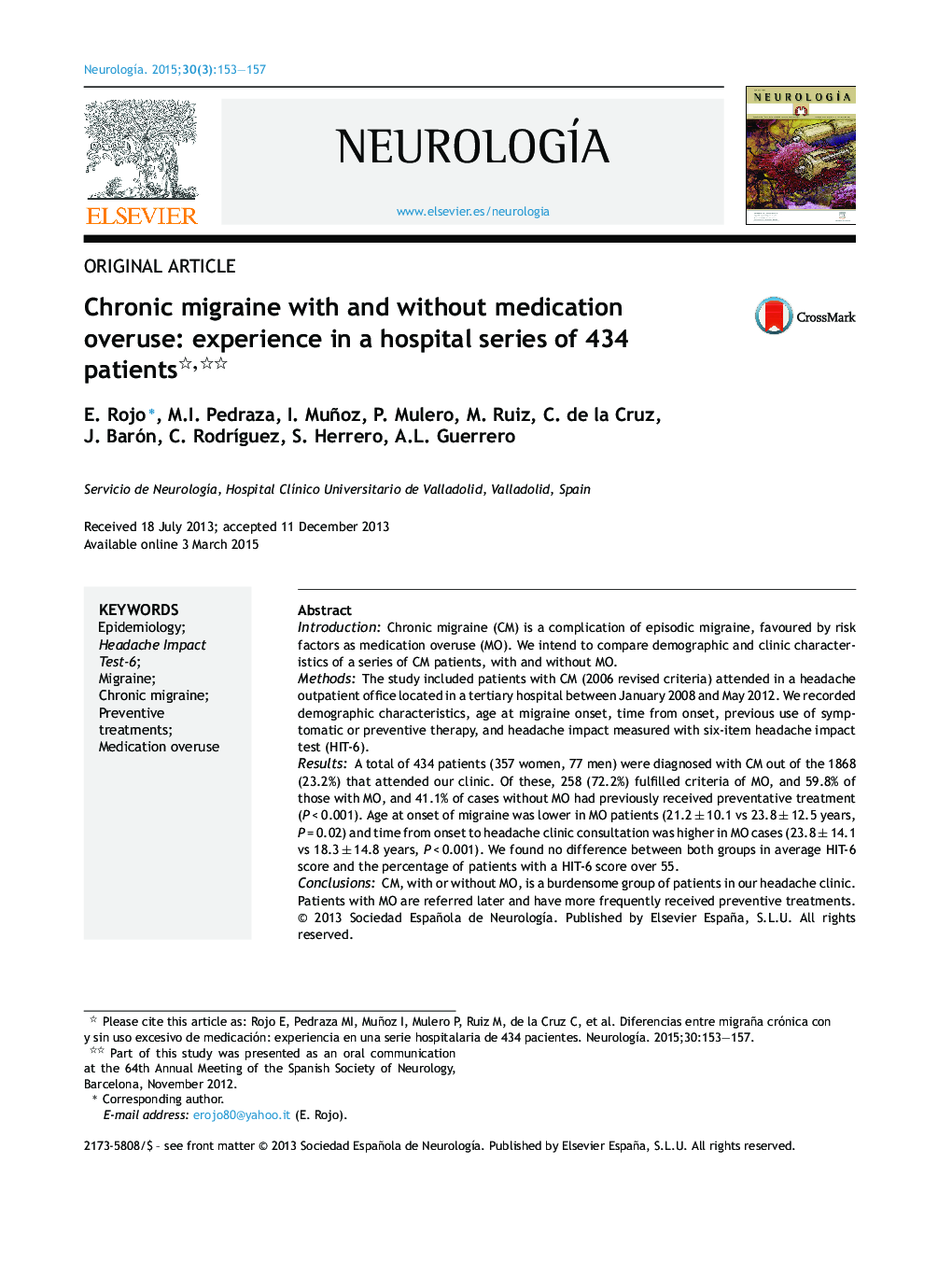| کد مقاله | کد نشریه | سال انتشار | مقاله انگلیسی | نسخه تمام متن |
|---|---|---|---|---|
| 3077302 | 1189134 | 2015 | 5 صفحه PDF | دانلود رایگان |
IntroductionChronic migraine (CM) is a complication of episodic migraine, favoured by risk factors as medication overuse (MO). We intend to compare demographic and clinic characteristics of a series of CM patients, with and without MO.MethodsThe study included patients with CM (2006 revised criteria) attended in a headache outpatient office located in a tertiary hospital between January 2008 and May 2012. We recorded demographic characteristics, age at migraine onset, time from onset, previous use of symptomatic or preventive therapy, and headache impact measured with six-item headache impact test (HIT-6).ResultsA total of 434 patients (357 women, 77 men) were diagnosed with CM out of the 1868 (23.2%) that attended our clinic. Of these, 258 (72.2%) fulfilled criteria of MO, and 59.8% of those with MO, and 41.1% of cases without MO had previously received preventative treatment (P < 0.001). Age at onset of migraine was lower in MO patients (21.2 ± 10.1 vs 23.8 ± 12.5 years, P = 0.02) and time from onset to headache clinic consultation was higher in MO cases (23.8 ± 14.1 vs 18.3 ± 14.8 years, P < 0.001). We found no difference between both groups in average HIT-6 score and the percentage of patients with a HIT-6 score over 55.ConclusionsCM, with or without MO, is a burdensome group of patients in our headache clinic. Patients with MO are referred later and have more frequently received preventive treatments.
ResumenIntroducciónLa migraña crónica (MC) es una evolución de la migraña episódica favorecida por factores de riesgo, entre los que se encuentra el uso excesivo de medicación (UEM). Pretendemos comparar características clínicas y demográficas de una serie de casos de MC, con y sin UEM.MétodosPacientes con MC (criterios revisados 2006) atendidos en una consulta monográfica de cefaleas de un hospital terciario entre enero del 2008 y mayo del 2012. Recogimos datos demográficos, evolución, utilización previa de preventivos e impacto de la migraña medido con la escala HIT-6.ResultadosCuatrocientos treinta y cuatro pacientes (357 mujeres, 77 varones) fueron diagnosticados de MC entre un total de 1,868 (23,2%) atendidos en la mencionada consulta durante el periodo de inclusión. Doscientos cincuenta y ocho (72,2%) presentaban UEM. El 59,8% de los casos con UEM recibieron previamente tratamiento preventivo frente al 41,1% sin UEM (p < 0,001). La edad de inicio de la migraña fue menor en los pacientes con UEM (21,2 ± 10,1 vs. 23,8 ± 12,5 años; p = 0,02) y el tiempo de evolución al llegar a nuestra consulta mayor en los pacientes con UEM (23,8 ± 14,1 vs. 18,3 ± 14,8 años; p < 0,001). No encontramos diferencia en la puntuación HIT-6 o el porcentaje de casos con HIT-6 mayor de 55 entre ambos grupos.ConclusionesLa MC con o sin UEM es una afección frecuente y discapacitante en una consulta de cefaleas. En nuestra población, los pacientes con UEM llegan a la consulta tras una evolución más larga, en la que ya recibieron tratamientos preventivos.
Journal: Neurología (English Edition) - Volume 30, Issue 3, April 2015, Pages 153–157
